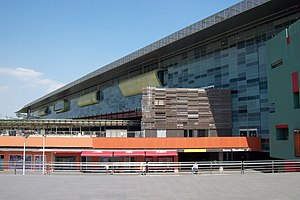Roma Tiburtina railway station
|
Roma Tiburtina
|
|
|---|---|
 |
|
| Location | Piazzale Stazione Tiburtina 00100 Roma RM Italy |
| Coordinates | 41°54′37″N 12°31′51″E / 41.91028°N 12.53083°ECoordinates: 41°54′37″N 12°31′51″E / 41.91028°N 12.53083°E |
| Operated by | Centostazioni |
| Line(s) |
Firenze–Roma Roma–Pescara |
| Distance | 4.505 km (2.799 mi) from Roma Termini |
| Platforms | 20 |
| Construction | |
| Architect | Paolo Desideri (2011 building) |
| History | |
| Opened | 1866 |
| Rebuilt | November 28, 2011 |
| Electrified | 3,000 V |
| Location | |
Roma Tiburtina is the second largest railway station in Rome, after Roma Termini. Located in the north-eastern part of the city, it is being redeveloped as a hub for the Italian high-speed rail services instead of Termini, which is a terminal station. The station is connected to the Rome's Metro line B by Tiburtina metro station. The new Tiburtina is dedicated to the traditional regional trains and to the high-speed rail services on the Milan-Naples line. The new station is expected to reach a daily ridership of over 450,000 by 2015. The station is served by 140 high-speed trains and 290 regional trains every day. The major advantage of the station for high-speed services is that it is a through station, meaning trains travelling from Turin/Milan to Naples/Salerno do not need to turn around.
The station was originally opened in 1866.
In 2001, a British University professor was killed when an escalator fell apart trapping her in a hole which had appeared. A local train driver, 38, who tried to free her also lost a leg, along with a third person who fell into the mechanism.
In 2004, plans were prepared for an upgrade of the station, with works commencing in 2007 at an expected cost of €155 million. The new station is expected to handle 300,000 passengers daily. By November 2011, all the works had cost €330 million.
A fire broke out in the relay room on the west side of the station at 4am on 24 July 2011. At 6am, water was cut from five neighbourhoods in order to facilitate efforts by the fire brigade to fight the fire. The metro line B was also temporarily closed between Castro Pretorio and Monti Tiburtini. As the fire broke out in the relay room, most controls for tracks and traffic signals were rendered unusable, leaving a vital part of the Italian rail network disabled with significant train delays throughout the country. The damage to the structure rendered the building in danger of collapse, with problems and delays going on for a long time after the accident.
...
Wikipedia

